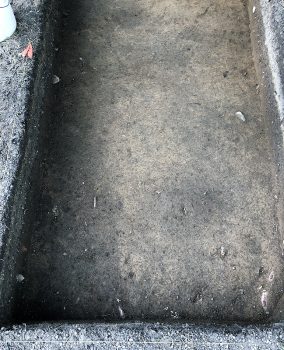Back to Dispatches from Field School
Field School 2018 – Week 4
Kyle Vanhoy — College of William & Mary
“Extremes”

Field school students Kyle Vanhoy (left) and Patrick Hodge consider an artifact found in their excavation unit
The theme of this week has been extremes. The first day of the week was spent out in the hot, hot sun with a heat index of over 100, yet out there we were, still working. To add to the week of extremes, we have had the pleasure of working with a visiting geophysicist, named Dr. Tim Horsley (editor’s note: check out more of Dr. Horsley’s work on his website). A geophysicist works in a subdomain of Archaeology, but not what we call a “dirt archaeologist.” Instead, Dr. Horsley spends his time using advanced imaging techniques such a Ground Penetrating Radar and Magnetometry. Both of these techniques allow you to peer into the ground without having to dig. It is a useful tool to help the archaeologists know where to dig. That Tuesday, I was out helping Dr. Horsley set up his 30×30 meter grid. In other words, I spent the morning walking around a field, taking measurements with a total station, and placing little plastic flags in the ground. In turn, the grid provides Dr. Horsley with exact edges and coordinates, so he can place his data into a map. All of the field school students got a chance to help out Dr. Horsley as he worked.
The next extreme of the week was on Wednesday. For us, it was known as Midterm day. After much date memorization and artifact identification, we trooped into the artifact collection room to await our fates. Fortunately, the midterm was not that long, nor was it ridiculously hard. I have it on good authority that we all passed.
The third extreme happened on Thursday. Now, the day started off a bit overcast and windy, and for those working outside, it was a treat! As the afternoon rolled around, things became a darker, perhaps a bit windier. And then it hit. Originally just a small drizzle, we kept working, albeit a tad bit more wet. The rain picked up and then fell off, and we kept working. But then it hit again, and oh did it rain. We all scrambled to save the ever-important total station and note box, and then got the tarps set up over the units to preserve them. Needless to say, we set a record time for site cleanup that day.

The floor of an excavation unit. Note the fence line running along the left side of the unit and a small post hole just right of center
The final extreme was for Saturday. On Saturday, most of the units were almost ready to be closed up. Features abounded. At least two post holes, a plethora of roots, and a fence line that can be seen running through two of the units, a full 20 feet of 17th-century trench. Even if all finds are cool, some of the coolest have been two balls of lead shot, a small glass bead, and pieces of pottery that we can all now identify and date. Lots of progress has been made in this week of extremes, and we are all excited to see what the next week has in store. We just started opening up a new unit today, taking off the sod and topsoil, a whole new set of artifacts just waiting to be found.


